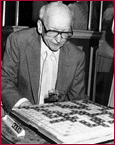

During the Great Depression, an out-of-work architect named Alfred Mosher Butts decided to invent a board game. He did some market research and concluded that games fall into three categories: number games, such as dice and bingo; move games, such as chess and checkers; and word games, such as anagrams.
Butts wanted to create a game that combined the vocabulary skills of crossword puzzles and anagrams, with the additional element of chance. The game was originally named Lexico, but Butts eventually decided to call the game "Criss-Cross Words".
Butts studied the front page of The New York Times to calculate how often each of the 26 letters of the English language was used. He discovered that vowels appear far more often than consonants, with E being the most frequently used vowel. After figuring out frequency of use, Butts assigned different point values to each letter and decided how many of each letter would be included in the game.
The letter S posed a problem. While it's frequently used, Butts decided to include only four S's in the game, hoping to limit the use of plurals. After all, he didn't want the game to be too easy!
Butts got it just right. His basic cryptographic analysis of our language and his original tile distribution have remained valid for almost three generations and for billions of games played.
The boards for the first Criss-Cross Words game were hand drawn with his architectural drafting equipment, reproduced by blueprinting and pasted on folding checkerboards. The tiles were similarly hand-lettered, then glued to quarter-inch balsa and cut to match the squares on the board.

Butts' first attempts to sell his game to established game manufacturers were failures, but he didn't give up. He and his partner, game-loving entrepreneur James Brunot, refined the rules and design of the game, and renamed it Scrabble. The name, which means "to grope frantically", was trademarked in 1948.
The first Scrabble "factory" was an abandoned schoolhouse in Dodgington, Connecticut, where Brunot and friends turned out 12 games an hour. The letters were stamped on wooden tiles one at a time. Later, boards, boxes and tiles were made elsewhere and sent to the factory for assembly and shipping.

The first four years were a struggle. In 1949, the Brunot's made 2,400 sets and lost $450. As so often happens in the game business, Scrabble plugged along, gaining slow but steady popularity among a comparative handful of consumers. Then in the early 1950s, as legend has it, the president of Macy's discovered the game on vacation, and ordered some for his store. Within a year, everyone "had to have one", and Scrabble sets were being rationed to stores around the country.
In 1952, the Brunots realized they could no longer make the games fast enough to meet the growing interest. They licensed Selchow and Righter Company, a well-known game manufacturer founded in 1867, to market and distribute the games in the United States and Canada.
Even Selchow and Righter had to step up production to meet the overwhelming demand for the Scrabble game. As stories about it appeared in national newspapers, magazines and on television, it seemed that everybody had to have a set immediately. In 1972, Selchow and Righter purchased the trademark Scrabble from Brunot, thereby giving them the exclusive rights to all Scrabble Brand products and entertainment services in the United States and Canada.
Continue Reading


